engine Citroen C3 2017 2.G Repair Manual
[x] Cancel search | Manufacturer: CITROEN, Model Year: 2017, Model line: C3, Model: Citroen C3 2017 2.GPages: 450, PDF Size: 10.11 MB
Page 197 of 450

195
B618_en_Chap07_info-pratiques_ed01-2016
TOTAL & CITROËN
Partners in performance and
protecting the environment
Innovation in the search for
performance
For over 40 years, the TOTAL Research and
Development departments have developed lubricants
for CITROËN, to match the latest technical innovations
on CITROËN vehicles, both for competition and for
everyday motoring.
For you, this is an assurance that you will obtain the
best per formance from your engine.
Optimum protection for
your engine
By having your CITROËN vehicle
serviced with TOTAL lubricants, you are
contributing towards improving the life
and per formance of your engine, while
also protecting the environment.
7
Practical information
Page 198 of 450
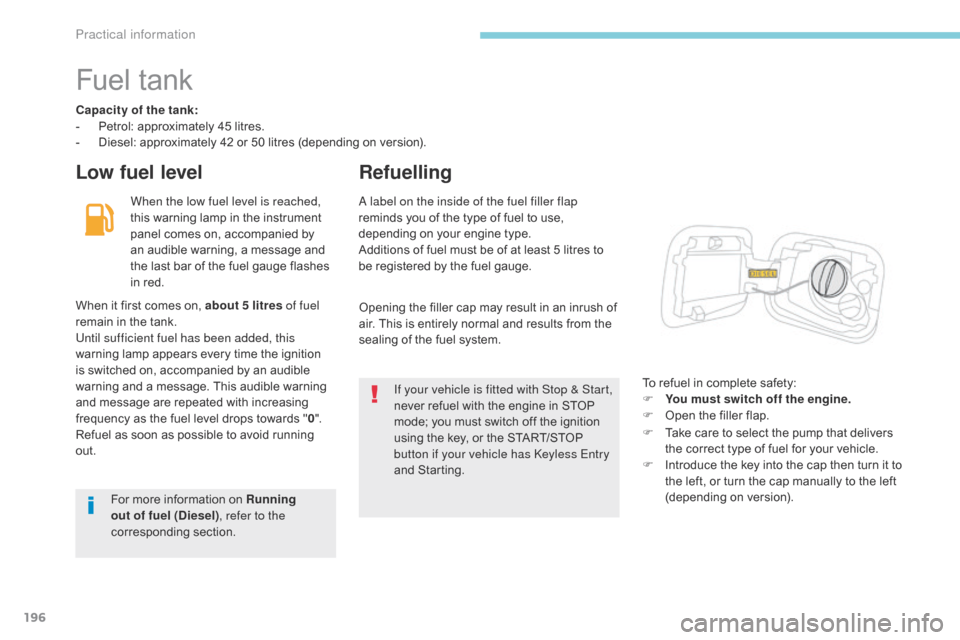
196
B618_en_Chap07_info-pratiques_ed01-2016
Fuel tank
Capacity of the tank:
- Pe trol: approximately 45 litres.
-
D
iesel: approximately 42 or 50 litres (depending on version).
Low fuel level Refuelling
When the low fuel level is reached,
this warning lamp in the instrument
panel comes on, accompanied by
an audible warning, a message and
the last bar of the fuel gauge flashes
in red.
To refuel in complete safety:
F
Y
ou must switch off the engine.
F
O
pen the filler flap.
A label on the inside of the fuel filler flap
reminds you of the type of fuel to use,
depending on your engine type.
Additions of fuel must be of at least 5 litres to
be registered by the fuel gauge.
When it first comes on, about 5 litres of fuel
remain in the tank.
Until sufficient fuel has been added, this
warning lamp appears every time the ignition
is switched on, accompanied by an audible
warning and a message. This audible warning
and message are repeated with increasing
frequency as the fuel level drops towards " 0".
Refuel as soon as possible to avoid running
out. Opening the filler cap may result in an inrush of
air. This is entirely normal and results from the
sealing of the fuel system.
If your vehicle is fitted with Stop & Start,
never refuel with the engine in STOP
mode; you must switch off the ignition
using the key, or the START/STOP
button if your vehicle has Keyless Entry
and Starting.
For more information on Running
out of fuel (Diesel) , refer to the
corresponding section. F
T
ake care to select the pump that delivers
the correct type of fuel for your vehicle.
F
I
ntroduce the key into the cap then turn it to
the left, or turn the cap manually to the left
(depending on version).
Practical information
Page 199 of 450

197
B618_en_Chap07_info-pratiques_ed01-2016
F Remove the cap and place it on its support (on the filler flap).
F
I
ntroduce the filler nozzle and push it in as
far as possible before starting to refuel (risk
of blowback).
F
M
aintain this position throughout the
refuelling operation.
Once you have finished refuelling:
F
R
efit the filler cap.
F
T
urn the key to the right then remove it
from the cap, or turn the cap manually to
the right (depending on version).
F
P
ush the fuel flap to close it. If you are filling your tank to the top, do not
persist after the 3
rd cut-off
; this could cause
malfunctions.
Your vehicle is fitted with a catalytic converter,
which helps to reduce the level of harmful
emissions in the exhaust gases.
For petrol engines, you must use unleaded
fuel.
The filler neck is narrower, allowing only
unleaded petrol nozzles to be introduced.
Your vehicle is equipped with a safety device
which cuts off the fuel supply in the event of a
collision.
Fuel cut- of f
If you have put in the wrong fuel
for your vehicle, you must have the
fuel tank drained and filled with
the correct fuel before star ting the
engine.
7
Practical information
Page 200 of 450
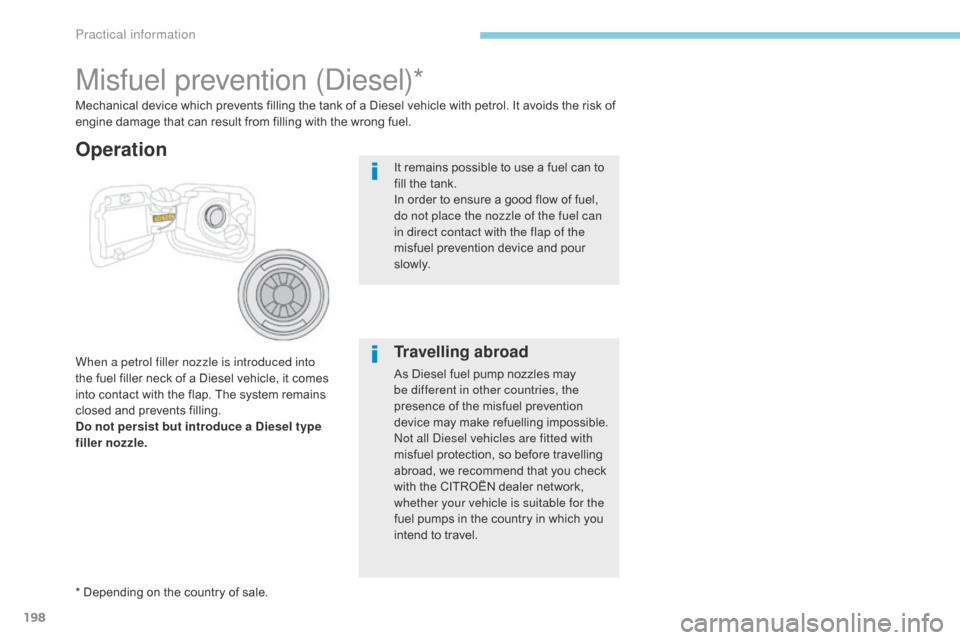
198
B618_en_Chap07_info-pratiques_ed01-2016
Misfuel prevention (Diesel)*
When a petrol filler nozzle is introduced into
the fuel filler neck of a Diesel vehicle, it comes
into contact with the flap. The system remains
closed and prevents filling.
Do not persist but introduce a Diesel type
filler nozzle.
* Depending on the country of sale. Mechanical device which prevents filling the tank of a Diesel vehicle with petrol. It avoids the risk of
engine damage that can result from filling with the wrong fuel.It remains possible to use a fuel can to
fill the tank.
In order to ensure a good flow of fuel,
do not place the nozzle of the fuel can
in direct contact with the flap of the
misfuel prevention device and pour
s l ow l y.Travelling abroad
As Diesel fuel pump nozzles may
be different in other countries, the
presence of the misfuel prevention
device may make refuelling impossible.
Not all Diesel vehicles are fitted with
misfuel protection, so before travelling
abroad, we recommend that you check
with the CITROËN dealer network,
whether your vehicle is suitable for the
fuel pumps in the country in which you
intend to travel.
Operation
Practical information
Page 201 of 450
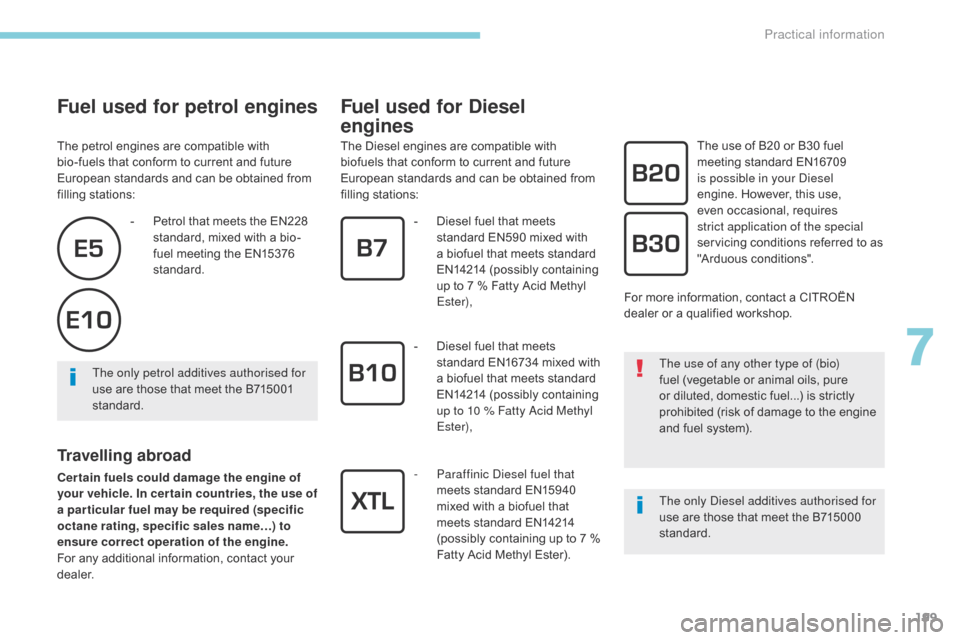
199
B618_en_Chap07_info-pratiques_ed01-2016
Fuel used for petrol engines
The petrol engines are compatible with
bio-fuels that conform to current and future
European standards and can be obtained from
filling stations:
Fuel used for Diesel
engines
The Diesel engines are compatible with
biofuels that conform to current and future
European standards and can be obtained from
filling stations:
-
Pe
trol that meets the EN228
standard, mixed with a bio-
fuel meeting the EN15376
standard. -
D
iesel fuel that meets
standard EN590 mixed with
a biofuel that meets standard
EN14214 (possibly containing
up to 7 % Fatty Acid Methyl
Ester), The use of B20 or B30 fuel
meeting standard EN16709
is possible in your Diesel
engine. However, this use,
even occasional, requires
strict application of the special
servicing conditions referred to as
"Arduous conditions".
-
D
iesel fuel that meets
standard EN16734 mixed with
a biofuel that meets standard
EN14214 (possibly containing
up to 10 % Fatty Acid Methyl
Ester),
-
P
araffinic Diesel fuel that
meets standard EN15940
mixed with a biofuel that
meets standard EN14214
(possibly containing up to 7 %
Fatty Acid Methyl Ester). The use of any other type of (bio)
fuel (vegetable or animal oils, pure
or diluted, domestic fuel...) is strictly
prohibited (risk of damage to the engine
and fuel system).
The only petrol additives authorised for
use are those that meet the B715001
standard. For more information, contact a CITROËN
dealer or a qualified workshop.
The only Diesel additives authorised for
use are those that meet the B715000
standard.
Travelling abroad
Cer tain fuels could damage the engine of
your vehicle. In cer tain countries, the use of
a par ticular fuel may be required (specific
octane rating, specific sales name…) to
ensure correct operation of the engine.
For any additional information, contact your
dealer.
7
Practical information
Page 203 of 450
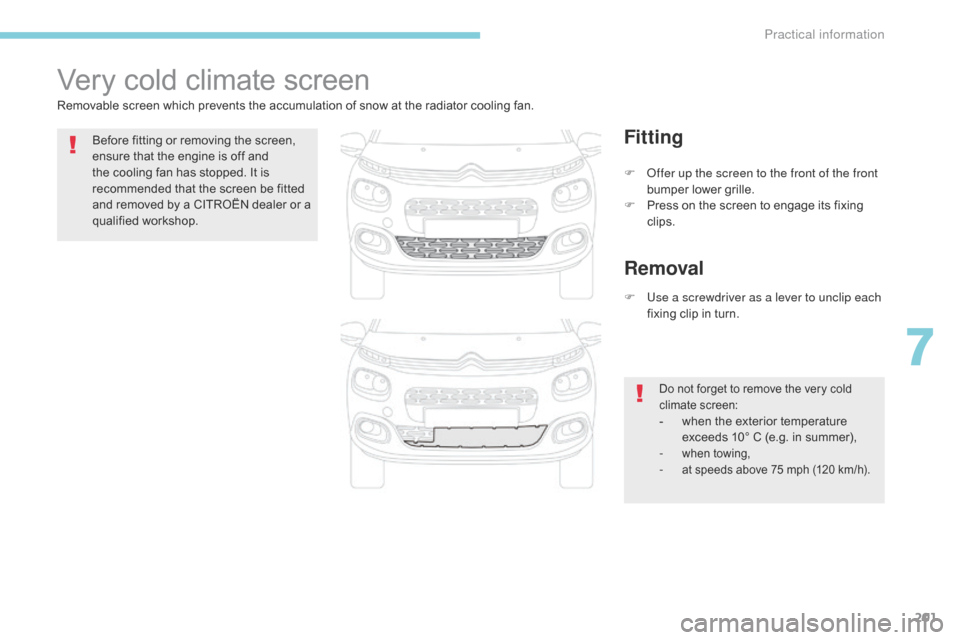
201
B618_en_Chap07_info-pratiques_ed01-2016
Very cold climate screen
Removable screen which prevents the accumulation of snow at the radiator cooling fan.Before fitting or removing the screen,
ensure that the engine is off and
the cooling fan has stopped. It is
recommended that the screen be fitted
and removed by a CITROËN dealer or a
qualified workshop.
Fitting
F Offer up the screen to the front of the front bumper lower grille.
F
P
ress on the screen to engage its fixing
clips.
Removal
F Use a screwdriver as a lever to unclip each fixing clip in turn.
Do not forget to remove the very cold
climate screen:
- when the exterior temperature exceeds 10° C (e.g. in summer),
-
when towing,- at speeds above 75 mph (120 km/h).
7
Practical information
Page 205 of 450
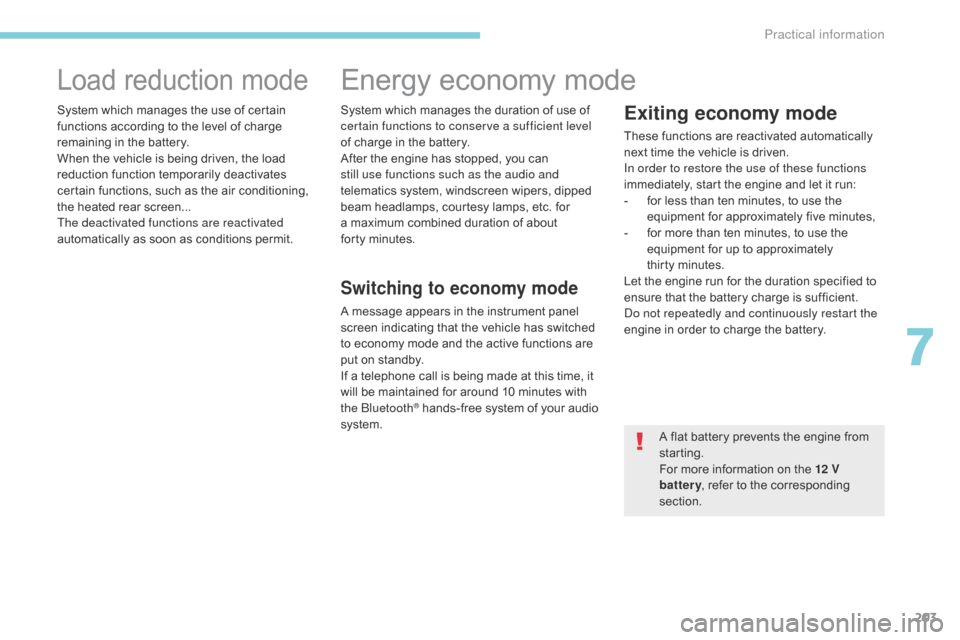
203
B618_en_Chap07_info-pratiques_ed01-2016
Load reduction mode
System which manages the use of certain
functions according to the level of charge
remaining in the battery.
When the vehicle is being driven, the load
reduction function temporarily deactivates
certain functions, such as the air conditioning,
the heated rear screen...
The deactivated functions are reactivated
automatically as soon as conditions permit.System which manages the duration of use of
certain functions to conserve a sufficient level
of charge in the battery.
After the engine has stopped, you can
still use functions such as the audio and
telematics system,
windscreen wipers, dipped
beam headlamps,
courtesy lamps, etc. for
a maximum combined duration of about
forty
m
inutes.
Energy economy mode
Switching to economy mode
A message appears in the instrument panel
screen indicating that the vehicle has switched
to economy mode and the active functions are
put on standby.
If a telephone call is being made at this time, it
will be maintained for around 10 minutes with
the Bluetooth
® hands-free system of your audio
system.
Exiting economy mode
These functions are reactivated automatically
next time the vehicle is driven.
In order to restore the use of these functions
immediately, start the engine and let it run:
-
f
or less than ten minutes, to use the
equipment for approximately five minutes,
-
f
or more than ten minutes, to use the
equipment for up to approximately
thirty
m
inutes.
Let the engine run for the duration specified to
ensure that the battery charge is sufficient.
Do not repeatedly and continuously restart the
engine in order to charge the battery.
A flat battery prevents the engine from
starting.
For more information on the 12 V
battery , refer to the corresponding
section.
7
Practical information
Page 208 of 450
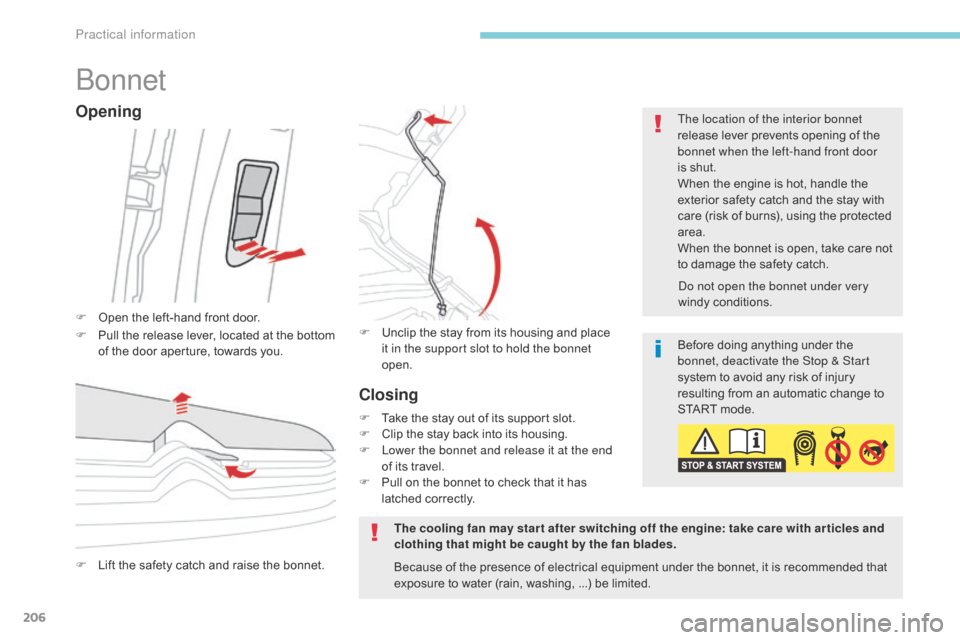
206
B618_en_Chap07_info-pratiques_ed01-2016
Bonnet
F Open the left-hand front door.The location of the interior bonnet
release lever prevents opening of the
bonnet when the left-hand front door
is shut.
When the engine is hot, handle the
exterior safety catch and the stay with
care (risk of burns), using the protected
area.
When the bonnet is open, take care not
to damage the safety catch.
F
L
ift the safety catch and raise the bonnet. F
U nclip the stay from its housing and place
it in the support slot to hold the bonnet
open.
Opening
F Pull the release lever, located at the bottom of the door aperture, towards you.
The cooling fan may star t after switching off the engine: take care with ar ticles and
clothing that might be caught by the fan blades.Do not open the bonnet under very
windy conditions.
Closing
F Take the stay out of its support slot.
F
C lip the stay back into its housing.
F
L
ower the bonnet and release it at the end
of its travel.
F
P
ull on the bonnet to check that it has
latched correctly.
Because of the presence of electrical equipment under the bonnet, it is recommended that
exposure to water (rain, washing,
...) be limited.Before doing anything under the
bonnet, deactivate the Stop & Start
system to avoid any risk of injury
resulting from an automatic change to
START mode.
Practical information
Page 209 of 450
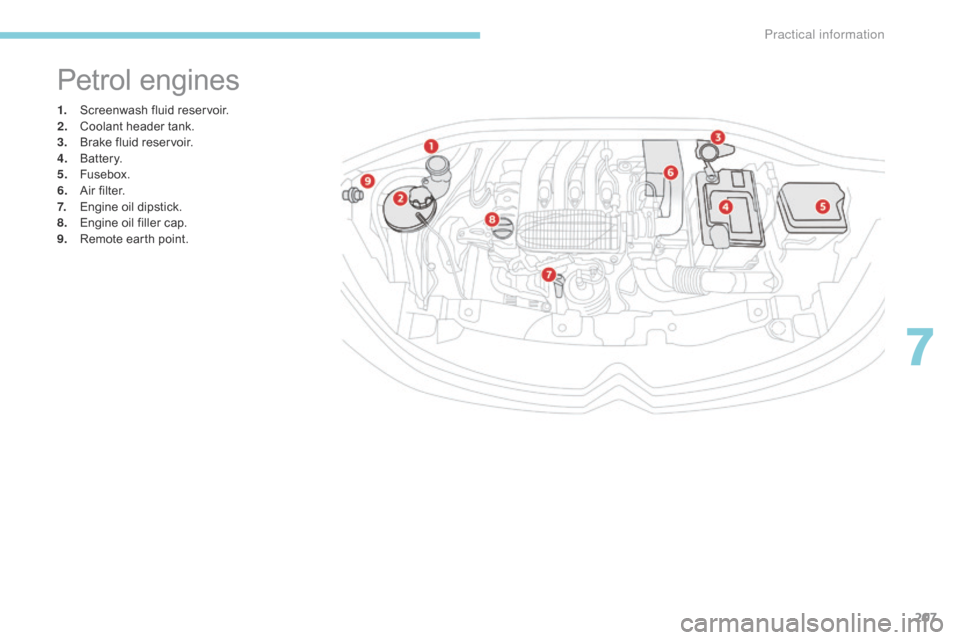
207
B618_en_Chap07_info-pratiques_ed01-2016
1. Screenwash fluid reservoir.
2. Coolant header tank.
3.
B
rake fluid reservoir.
4.
B
attery.
5.
F
usebox.
6.
A
ir filter.
7.
E
ngine oil dipstick.
8.
E
ngine oil filler cap.
9.
R
emote earth point.
Petrol engines
7
Practical information
Page 210 of 450
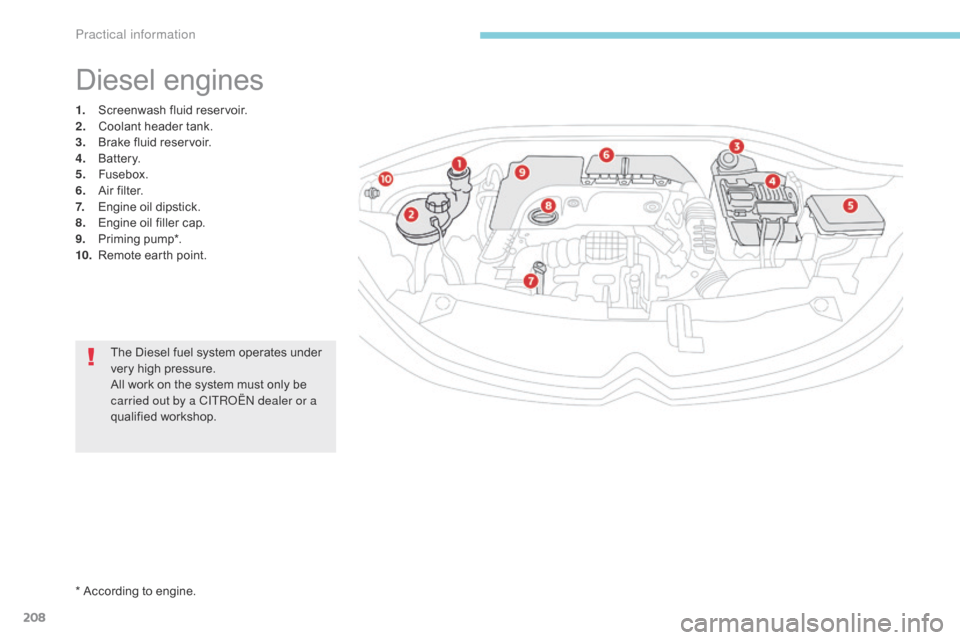
208
B618_en_Chap07_info-pratiques_ed01-2016
1. Screenwash fluid reservoir.
2. Coolant header tank.
3.
B
rake fluid reservoir.
4.
B
attery.
5.
F
usebox.
6.
A
ir filter.
7.
E
ngine oil dipstick.
8.
E
ngine oil filler cap.
9.
P
riming pump*.
10.
R
emote earth point.
Diesel engines
* According to engine. The Diesel fuel system operates under
very high pressure.
All work on the system must only be
carried out by a CITROËN dealer or a
qualified workshop.
Practical information